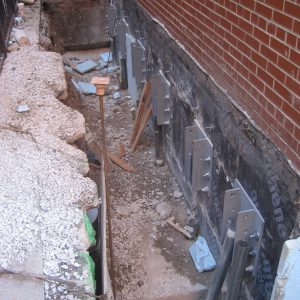
Resistance piers, also known as push piers or jacked piers, are structural elements used to stabilize and support foundations that have experienced settlement or movement. They are designed to address vertical foundation settlement issues.
Resistance piers consist of steel pipes that are driven into the ground beneath the foundation until they reach a stable load-bearing stratum. The installation process involves using hydraulic equipment to push the piers into the soil. The piers are driven deep enough to bypass unstable or weak soil layers and reach more competent soil or bedrock.
Once the resistance piers are installed, hydraulic jacks are utilized to transfer the weight of the structure onto the piers, lifting and stabilizing the foundation. The piers are strategically placed along the foundation perimeter to evenly distribute the load and provide long-term stability.
Resistance piers are commonly used when foundation settlement is caused by factors such as expansive clay soil, poor soil compaction, or moisture-related issues. They offer a reliable solution for addressing foundation settlement, preventing further damage, and restoring the structural integrity of home, buildings and other structures.
Resistance piers have various applications in addressing foundation settlement and stabilization issues. Some of the common applications for resistance piers include:
Residential Buildings: Resistance piers are commonly used in residential properties, including single-family homes, townhouses, and condominiums, to stabilize foundations that have experienced settlement. They can address issues caused by factors like soil movement, poor compaction, or expansive clay.
Commercial and Industrial Structures: Resistance piers are also utilized in commercial and industrial buildings, such as offices, warehouses, and factories, to stabilize foundations affected by settlement. These structures often have larger footprints and higher loads, making resistance piers an effective solution for stabilizing their foundations.
Historical Buildings: Historical structures often require specialized foundation stabilization methods to preserve their architectural integrity. Resistance piers can be employed in historical buildings to address settlement issues without causing significant disturbance or damage to the structure.
Multi-story Buildings: Resistance piers can be used in multi-story buildings to stabilize foundations that have settled unevenly. The piers can be installed at various locations along the foundation to provide support and prevent further settlement.
Commercial and Infrastructure Projects: Resistance piers are also utilized in commercial construction projects, such as shopping centers, hospitals, and schools, as well as infrastructure projects like bridges and highways. They help ensure stable foundations for these large-scale structures, protecting them from settlement-related damage.
Reliable Foundation Stabilization: Resistance piers provide a reliable and proven method for stabilizing foundations that have experienced settlement. They address the underlying causes of settlement and ensure long-term stability for the structure.
Versatility: Resistance piers can be used in various types of structures, including residential, commercial, industrial, and historical buildings. They can accommodate different foundation types and loads, making them a versatile solution for a wide range of applications.
Minimal Disruption: The installation process for push piers is relatively non-intrusive. It does not require extensive excavation or disruptive construction work, minimizing disturbance to the property and occupants. This is particularly advantageous for occupied buildings or sensitive environments.
Cost-Effective: By addressing the root cause of settlement, push piers help prevent further damage and potentially costly repairs in the future.
Long-Term Solution: Once installed, resistance piers provide a permanent stabilization solution for the foundation. They are designed to withstand the test of time and provide lasting support to the structure.
Professional Expertise: Intech Anchoring Systems provides a comprehensive package of professional expertise, skilled personnel, and experienced engineering staff to ensure the overall success of your projects. By partnering with Intech, you gain access to a team that possesses the necessary knowledge and skills to deliver top-quality results, giving you the confidence that your projects will be completed to the highest standards of excellence.

Tim is the President of Intech Anchoring and has 25 years of experience in the Civil Engineering and Geostructural Industry. Tim has developed extensive industry knowledge by working to support the needs of specialty contractors at each and every business level. Tim’s diverse industry background has given him exposure to a wide variety civil construction projects, ranging from the simplest residential applications to the most complex commercial and industrial projects. Coupled with a highly skilled and educated team, Tim focuses on providing the highest quality products and solutions to Intech Anchoring’s customers in order to consistently exceed expectations.